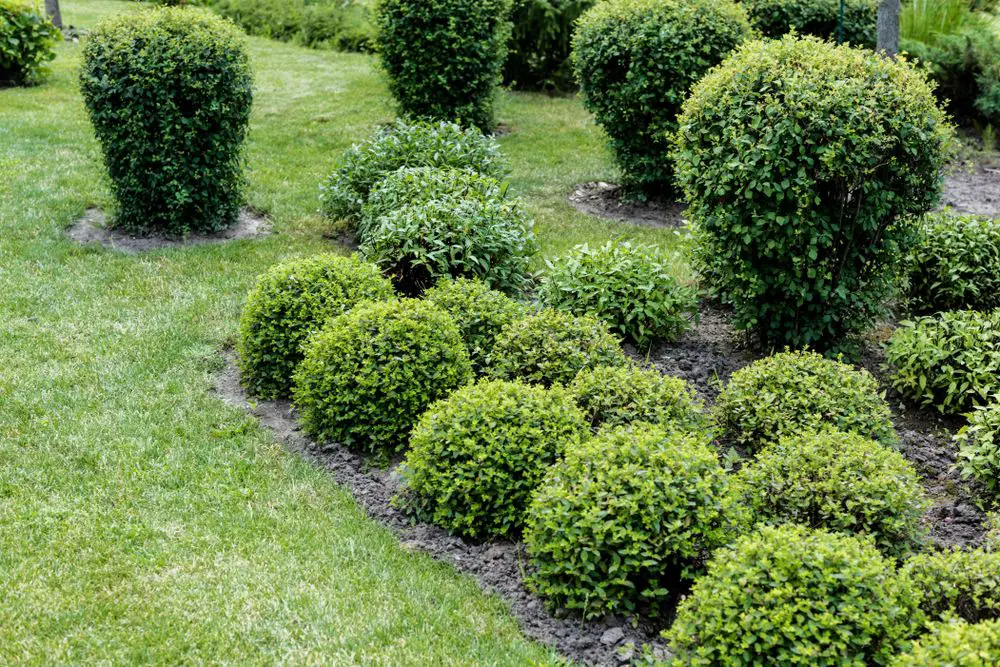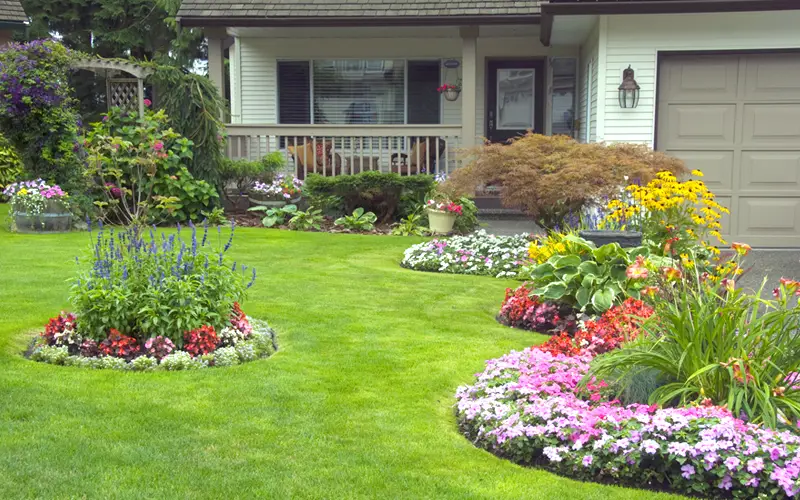Whether you want to increase the value of your property, impress your guests, or simply make your front yard a more aesthetically pleasing place, an attractive landscape design will make a huge difference.

However, maintaining your front yard landscape is the most challenging aspect. You don’t want to end up with a front-yard full of overgrown vegetation or stuff that doesn’t belong there.
Don’t worry; we’ve got you covered with 12 low-maintenance landscaping ideas for front yards that you’ll surely love. Stick around!
12 Best Front-Yard Landscape Ideas for Busy Bees
Your busy life shouldn’t prevent you from having an attractive front yard. Mix and match some of the ideas listed below to transform your front yard into a magical place.
1. Plant Native Species
Native plants are your best bet if you plan to include vegetation in your landscape design from a climate and weather conditions perspective.
Native plants will thrive in your front yard because they’ve adapted to the natural conditions in your area, making them more resistant to pests, diseases, and drought. These characteristics eliminate the need for expensive and routine maintenance to keep your plants alive.
2. Consider Xeriscaping

While we’re still on the subject of climate and weather conditions, let me introduce you to xeriscaping. Xeriscaping is a landscaping technique that focuses on creating a low-water landscape using drought-tolerant plants, mulching, and efficient irrigation systems.
Drought-tolerant plants require little maintenance and won’t need too much water, making them more cost-efficient. Xeriscaping is ideal if you live in a dry region. It can also help mitigate heat and provide a green space if you’re in an urban setting.
3. Add Perennial Plants

Perennials are plants that come back year after year, usually during the spring. They come in different shapes and colors, and they attract bees, hummingbirds, and small wildlife like rabbits.
Ideally, you should plant perennials that bloom at different times of the year so your front yard will always have colorful natural decorations.
Some popular perennials include chrysanthemum, bellflower, dahlia, primrose, and columbine. Be sure to look up the best perennials for your specific region.
4. Plant Evergreen Shrubs

As the name implies, evergreen shrubs maintain their green leaves year-round. You can count on these shrubs to provide a luscious green and additional texture to your front yard landscape even during winter.
Evergreen shrubs also serve as shelters for birds that bring an extra layer of vibrance and life to your front yard, making it a win-win situation for you and these little feathered cuties.
Consider adding bamboo, especially the varieties that grow well in pots, or California lilacs that bloom in May and June.
5. Use Ground Cover Plants

Apart from adding aesthetics to your front yard landscape, ground cover plants offer quite a few practical applications.
Ground cover plants prevent weed growth and erosion of your garden soil. They can also lessen dust, which would otherwise be present if you’ve got a barren spot in your front yard.
Ajuga, moss, creeping thyme, and clover are great ground cover plants since they require little maintenance. Most of them thrive even without the help of their gardener.
6. Group Plants Together
Grouping your plants based on their watering and sunlight requirements has many advantages apart from having an organized look in your front yard.
For instance, you can practice better water management and reduce your water bill. Also, the plants don’t suffer from over or under-watering, or too much or too little exposure to sunlight.
Grouping plants will help you save time managing them and save some money since you can maximize your resources when they are organized.
7. Install Mulch Beds

Not only will mulch beds provide your front yard with a neat appearance, but they can also prevent weeds from growing and provide moisture and nutrients to your plants!
There are two types of mulch: organic and inorganic.
If you want nutrients for your front yard plants, choose an organic mulch. To completely block weeds and have longer-lasting protection, inorganic mulch is better.
8. Use Decorative Containers

There are tons of decorative containers that you can use for your front yard landscape. They provide additional texture and appeal to your front yard.
You can use a flower basket, a traditional freestanding container, or a hanging container. The most important thing is to know which plant or flower goes well with which decorative container.
One great example is the rustic hanging container. A simple rusty bucket can make heads turn when it is studded with begonia, periwinkles, and coleus. For an added appeal, suspend it on a branch.
9. Install a Rock Garden

A rock garden is a beautiful and low-maintenance addition to your front yard landscape, and it comes with several benefits.
For starters, a rock garden requires less maintenance since there’s no need for frequent pruning or watering.
If you live in a dry region, it’s also a wonderful alternative since rocks and succulents can create a drought-resistant yet beautiful landscape centerpiece.
Further, a strategically placed rock garden can also prevent erosion if you live on a slope.
10. Create Pavers or Gravel Paths

Rather than a traditional sidewalk, install path walks made from pavers and gravel.
They add visual interest to your front yard but also reduce the lawn you need to mow—perfect if you have a busy schedule.
11. Incorporate Hardscaping

Hardscaping means adding man-made structures using inanimate materials.
A pergola, patio, and retaining wall are all great examples of hardscape structures that add a sophisticated look to your landscape and reduce the areas that constantly need your attention.
12. Use Synthetic Turf and Landscape Fabric

Synthetic turf allows you to have a lush green lawn without all of the upkeep since it requires no watering, mowing, or fertilizing.
Landscape fabric, on the other hand, allows you to cover areas where you don’t want weed growth, greatly reducing maintenance time.
Things to Consider When Selecting Plants for Your Front Yard
When selecting plants for your landscape design, consider sun exposure, rainfall, temperature, and soil condition.
- Sun Exposure: Plants need sunlight to grow. However, some species require more sun exposure than others. Research the best plants to have in your front yard based on the amount of sunlight your area receives.
- Rainfall: Water is also a vital necessity for plants. Rainfall is one of the natural ways by which plants can get water. As with sun exposure, pick plants based on the amount of rainfall your area gets.
- Temperature: Some plants survive on long winter days but will immediately perish in a hot environment and vice versa. So, make sure to consider the climate where you live before adding plants to your front yard landscape.
- Soil Condition: This refers to the capacity of soil to support and sustain plants. Is your front yard’s soil dry, moist, rocky, or sandy? Your answer to these questions should help you decide what plants to add to your front yard design.
Final Reminders
Landscaping is all about creating and putting together different elements to create a vibrant and visually appealing front yard. You can mix and match some of the above-listed ideas, along with others that you might have in mind, to create the front-yard setting of your dream.
My friendly reminder is to keep your front yard clean, first and foremost. The ideas shared in this article will surely lose their essence if your front yard is unorganized, untidy, and downright dirty. No amount of hardscape materials and perennials can beat a clean front yard.













